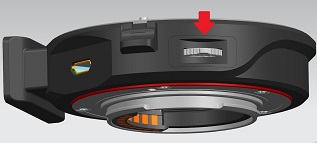Changing Iris

Iris display
Many cameras do not support apertures faster than (numerically smaller than) f/1.0. Therefore, with a Speed Booster, the boosted aperture is displayed on the LCD screen when a slow lens (f/1.8 or slower) is attached. If a fast lens (f/1.4 or faster) is used, the original pre-boost aperture is displayed, even though the actual aperture used is faster. Please take this into account when transferring exposure settings from a light meter.
Tip (for Blackmagic cameras with active MFT mount): the most common cause of failure to control the iris or display the iris value on a Blackmagic camera is a stuck lens release lock button. With the lens and the Speed Booster or Smart Adapter still attached, depress the lens release lock button of the camera body once, and after that communication between the Speed Booster and the Blackmagic camera will be restored with iris operation becoming functional again.
Changing iris on a legacy Panasonic camera
You may use either the camera body's controls to change iris, or use the jog lever on the Smart Adapter / Speed Booster (except Speed Booster S, or when using Canon CN-E 18-80mm T4.4 L lens, or when using Panasonic GH5 or newer camera).
Set camera to A (aperture priority) or M (manual exposure) mode. Push the jog lever on Speed Booster or Smart Adapter inward to turn on iris control, and flick the jog lever upward or downward to change iris using the jog lever on the Smart Adapter or Speed Booster.
 Push jog lever inward to turn off iris control with the Smart Adapter or Speed Booster.
Push jog lever inward to turn off iris control with the Smart Adapter or Speed Booster.
If jog lever is pushed inward for a second time, iris control with the Smart Adapter or Speed Booster's jog lever is turned on again.
With a variable-aperture zoom lens, iris value changes whilst zooming. With a f/4-5.6 lens for example, if iris is set to f/11 at the widest zoom position using jog lever, iris will become f/16 when zoomed to the maximum position.
The aperture you set with either method does not take effect in photo mode (A, M) until the moment a photo is taken. In movie mode (if your camera has a dedicated movie mode) the aperture you set takes effect immediately.
With Canon CN-E 18-80mm T4.4 L lens, set the IRIS A/M switch to A to control iris from the camera body and set it to M to control iris from the lens' iris ring. The jog lever of the adapter cannot be used to control the iris of a Cinema EOS CN-E lens.
If you use Panasonic GH5 or a newer camera body, set iris on the camera body. The jog lever on the adapter is instead used as a customizable function button that can be assigned to various functions on the camera body. Consult your camera's documentation on the configuration. Your GH5 firmware needs to be at least V2.2 for customizable function button to work.
Metabones App option controlling the behaviour of the jog lever
If the option 'Changing iris on JVC/Panasonic with adapter's jog lever requires inward push to activate' is checked, you do not need to push the jog lever inward to activate iris control. Instead, simply flicking the jog lever up or down will automatically move iris control from the camera body to Speed Booster/Smart Adapter. Regardless of whether this option is on or off, camera body iris control is restored by pushing the whole jog lever inward.
Changing iris on a passive MFT mount camera such as the original Blackmagic Cinema Camera
Note: Speed Booster S does not support passive MFT mount. The earliest batch of Speed Booster 0.58x for BMPCC (Blackmagic Pocket Cinema Camera) may require modification before passive MFT mount can be supported. Talk to Metabones technical support for service.
Connect a 5V power source (not included) capable of supplying at least 1A to the micro USB port. Flick the jog lever upward or downward to change iris.
Push jog lever inward to set lens to wide open. Push jog lever inward again to return to the previous iris value.
Auto Iris
We recommend against uing auto iris/aperture during video capture, such as the P (Program) and S (Shutter Priority) modes. EF mount lenses adjust iris in 1/8th stop steps which may result in visible disruption in the footage or oscillation of the iris. Use A (Aperture Priority) or M (Manual) exposure modes. This limitation does not apply to supported Canon Cinema EOS lenses (CN-E) which allows for a much finer iris adjustments.
Cinema EOS Lens
With Cinema EOS lenses such as CN-E 18-80mm T4.4 L, if the IRIS A/M switch is at the M (manual) position, the following functions may not work:
- Autofocus.
- Programmed (P) and Shutter Priority (S) exposure modes.
- For Olympus and OM System cameras, the IRIS A/M switch on the lens must be at the A position, or else the aperture chosen with the iris ring may not match the F-Number displayed, even in Aperture Priority and Manual exposure modes.
In A and M exposure modes on Panasonic, and on JVC, display is in F-stops, not T-stops.